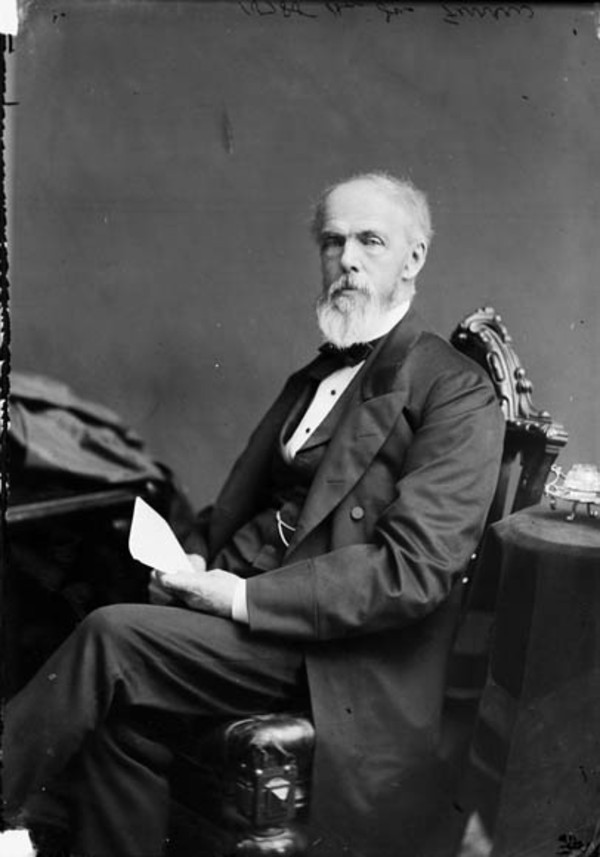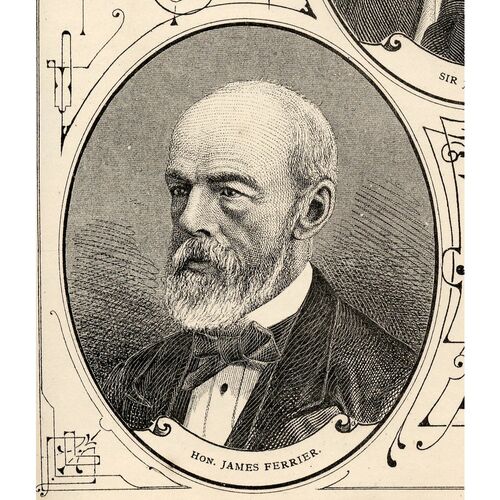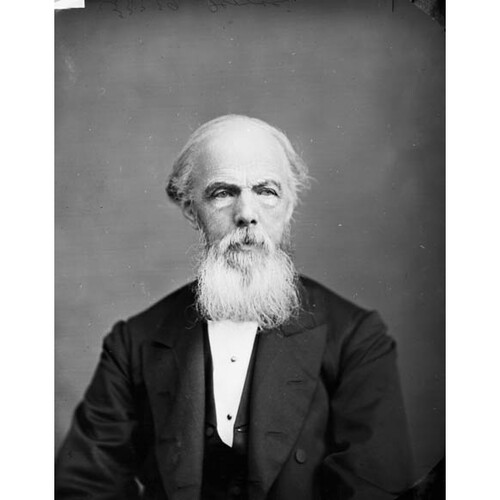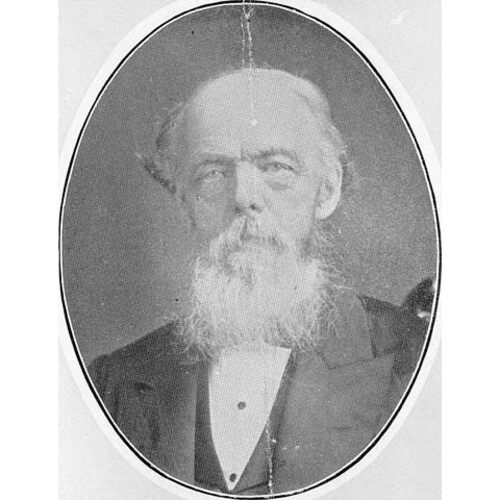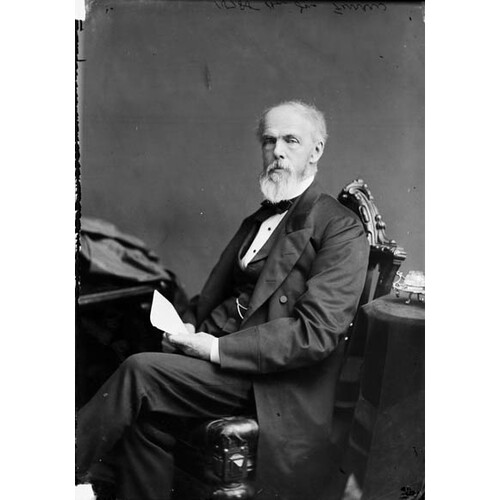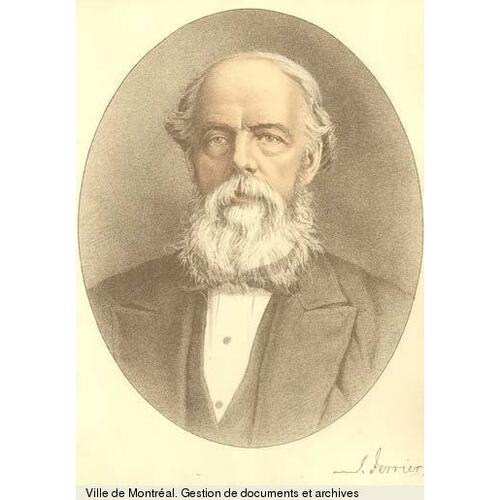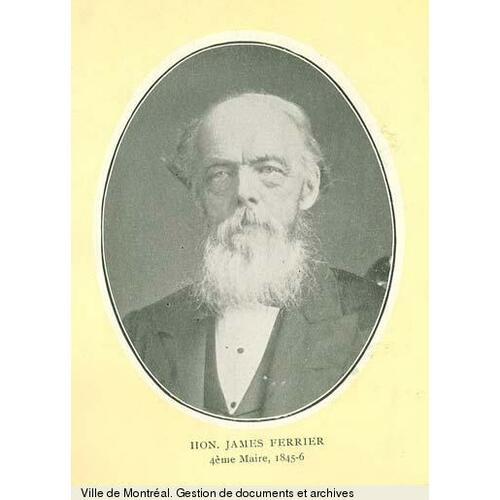FERRIER, JAMES, merchant, politician, railway promoter, and capitalist; b. 22 Oct. 1800 in Fife, Scotland; m. Mary Todd, and they had at least two sons and two daughters; d. 30 May 1888 in Montreal, Que.
James Ferrier emigrated from Scotland to Montreal in 1821 after several years of employment in a Perth mercantile house. He worked 18 months for a Montreal merchant and then opened the first store on Rue Notre-Dame, a residential street which soon became part of the city’s commercial hub. By 1836, when he withdrew from full-time involvement in trade, Ferrier had accumulated a substantial fortune not only from his store but also from the extensive real estate holdings he had acquired in the city. With Joseph Masson* and Harrison Stephens he was considered among the wealthiest Montrealers of the mid 19th century.
Using capital acquired during his early career, James Ferrier turned to larger financial ventures. With Augustin Cuvillier*, Albert Furniss, and William Edmonstone he was on the Montreal board of directors of the Bank of British North America, a British-based bank that began operations in Upper and Lower Canada under royal charter in the spring of 1837 with a nominal capital of £1,000,000. Ferrier was one of the incorporators of Molsons Bank in 1855 along with Montreal businessmen such as William Molson*, and he was a shareholder in several other Canadian banks. A promoter and long-time director of the New City Gas Company from its foundation in 1847, he was also active in the Montreal Fire Assurance Company, serving as its president for six years, an incorporator of the Montreal Credit Company with Hugh Allan in 1871, and in later years a director of two other insurance companies, the Guarantee Company of North America and the Accident Insurance Company of North America.
By 1847 Ferrier had considerable investments in his son James’s hardware firm, Bryson and Ferrier. In 1851 that partnerhsip was dissolved and James Jr was joined by his brother George Davies in the wholesale and retail hardware firm of Ferrier and Company. The credit agents of R. G. Dun and Company reported in 1856 that the young men were “brought up to & understand their bus[iness] well.” “The firm is called hot here, both on acct of good char[acter] & ability of the Partners, & the belief is that in case of any difficulty, the father would protect their paper.” James Ferrier Sr was reported to have advanced from $30,000 to $35,000 to his sons, and he retained undisclosed investments in the firm at least until it began to encounter financial difficulties in the mid 1870s. Ferrier continued to help his son James by purchasing partnerships for him in the Horse Nail Works, Ausable Chasm, N.Y., at $25,000 and the Horse Nail Works, Pointe-Saint-Charles (now part of Montreal), at $31,000. His son began to diversify his business interests in later years, and, after that, it becomes increasingly difficult to distinguish the financial involvements of father and son.
Venturing into industrial development in Canada East, James Sr leased and operated the Saint-Maurice ironworks from 1847 to 1851 and was a promoter and president of the Montreal Mining Company. Not surprisingly, his extensive business, financial, and industrial connections led to active involvement in two of Montreal’s most important railways, the Montreal and Lachine and the Grand Trunk. The former, chartered in 1846, was the first line built on the island of Montreal, and Ferrier was elected its president. Under his direction £75,000 in share capital was raised and the seven-mile line was in operation by mid November 1847. The Montreal and Lachine became the launching pad for an ambitious programme of railway expansion: the St Lawrence and Ottawa Grand Junction (never constructed) to go northwest from Lachine into the hinterland of the St Lawrence and Ottawa rivers, and the Lake St Louis and Province Line, united in 1850 with the Montreal and Lachine to form the Montreal and New York Railroad, to go south through Plattsburgh to New York City. After a series of costly and inconclusive battles with rival railways the Montreal and New York was brought into the Champlain and St Lawrence Railroad, which then became the Montreal and Champlain Railroad in 1857, and was soon in turn absorbed by the Grand Trunk. Although Ferrier had resigned from the presidency of the Montreal and Lachine and its branches in 1851, perhaps because of its increasing financial difficulties, he served as chairman of the Canadian board of directors of the Grand Trunk until his death, and was as well a director of the International Bridge Company, a Grand Trunk venture. He was also involved in other transportation projects such as the Canadian and West Indian Royal Mail Steamship Company and the Waterloo, Magog and Stanstead Railway. For Ferrier and Montreal businessmen like him, railways were a source of power and profit for their promoters, the financial institutions they represented, and the Montreal community at large.
In the political life of Montreal during the 1840s, Ferrier played an important role, first as an appointed member of the municipal council in 1841. After council positions became elective, he was alderman for East Ward in 1844. In 1845 he became mayor of the city; during his term in office he organized relief for the citizens of the Quebec City faubourg of Saint-Roch who were suffering the effects of a severe fire. On 27 May 1847 Ferrier was appointed to the Legislative Council where he remained until confederation. In 1867 he became a member of the dominion Senate and represented Victoria in the Legislative Council of Quebec; he held both posts until his death and was particularly active on the council’s private bills and railway committees. Like many other prominent businessmen of the era, Ferrier served as a justice of the peace and held the post of lieutenant-colonel in the local militia.
He also took an active part in religious and philanthropic endeavours. Several times president of the St Andrew’s Society, he also played a leading role at McGill College, as a member from 1845 until his death and as president from 1845 to 1852 of the Royal Institution for the Advancement of Learning, which in the latter year became the college’s governing body. The restoration of financial stability and order to McGill’s affairs after a period of great difficulty and uncertainty during the 1840s has been attributed largely to his efforts. In September 1884 he was appointed chancellor of McGill. He had travelled extensively throughout Europe, Africa, and Asia, and souvenirs of his travels were donated to the Natural History Society of Montreal and to McGill. Although he was originally a member of the Presbyterian St Gabriel Street Church, his numerous associations with John Torrance* and his sympathies for the Methodists led to his becoming a member of the St James Street Methodist Church, which he devoutly attended and where he regularly taught a Sunday school class. In addition he advanced the cause of Methodism throughout the city by contributing generously to the building of churches in Griffintown and in several suburbs. Ferrier filled almost every office open to a layman and served often as a delegate to its many conferences where he spoke strongly in favour of union of all Methodist churches. He took an interest in the Wesleyan Theological College in Montreal, was a member of the senate of Victoria College at Cobourg, Ont., was president of the Montreal Auxiliary Bible Society, and was an officer in both the Sabbath School Association of Canada and the French Canadian Missionary Society. He was, as well, active in the Montreal Protestant House of Industry and Refuge and in several temperance and prohibition societies, serving as president of the Quebec Temperance and Prohibitory League.
Ferrier died in Montreal following a brief illness; he was survived by his son James and one daughter, Margaret Watson, who had married John, son of David Torrance*. A sermon delivered at his funeral noted that “by his diligence and enterprise, combined with the strictest integrity, with clear intellect, a well-balanced judgment,” and “a prompt and untiring energy,” Ferrier had achieved commercial success. “He had deep convictions, firm Christian principles, and he shaped his life by them.”
AC, Montréal, Minutiers, J. W. Trenholme, 1 Jan. 1887. ANQ-Q, AP-G-134, Boîte 12. Baker Library, R. G. Dun & Co. credit ledger, Canada, 5: 35; 6: 35. McCord Museum (Montreal), J. H. Dorwin, “Antiquarian autographs.” Débats de la législature provinciale (G.-A. Desjardins et al.), [III]: 254–57; [IV]: 385–86; IX: 327–29. Hugh Johnston, Death abolished: a sermon preached . . . in St. James Street Methodist Church, Montreal, Sunday morning, October 9th, 1881, on the occasion of the death of Mrs. James Ferrier (Montreal, 1881); Memorial of the late Hon. Senator Ferrier, of Montreal: a sermon preached in St. James Street Methodist Church, on Sunday, June 3rd, 1888 . . . (Toronto, 1888). Myles Pennington, Railways and other ways: being reminiscences of canal and railway life during a period of sixty-seven years . . . (Toronto, 1896). W. J. Rattray, The Scot in British North America (4v., Toronto, 1880–84), II: 602. Gazette (Montreal), 31 May 1888. La Minerve, 12 mars 1853, 1 juin 1888. Montreal Witness, 8 June 1888. La Patrie, 1 juin 1888. Borthwick, Hist. and biog. gazetteer. Canada, an encyclopædia (Hopkins), I: 443–44, 478–90. Canadian biog. dict., II: 242–47. Canadian directory of parl. (J. K. Johnson), 201. CPC, 1877: 92–93. Dent, Canadian portrait gallery, IV: 93–94. Montreal directory, 1852: 352. Notman and Taylor, Portraits of British Americans, I. Terrill, Chronology of Montreal. G. Turcotte, Le Conseil législatif de Québec, 291–92. Campbell, Hist. of Scotch Presbyterian Church. S. B. Frost, McGill University: for the advancement of learning (1v. to date, Montreal, 1980– ). Histoire de la corporation de la cité de Montréal depuis son origine jusqu’à nos jours . . . , J.-C. Lamothe et al., édit. (Montréal, 1903).
Cite This Article
Gerald J. J. Tulchinsky, “FERRIER, JAMES,” in Dictionary of Canadian Biography, vol. 11, University of Toronto/Université Laval, 2003–, accessed January 9, 2026, https://www.biographi.ca/en/bio/ferrier_james_11E.html.
The citation above shows the format for footnotes and endnotes according to the Chicago manual of style (16th edition). Information to be used in other citation formats:
| Permalink: | https://www.biographi.ca/en/bio/ferrier_james_11E.html |
| Author of Article: | Gerald J. J. Tulchinsky |
| Title of Article: | FERRIER, JAMES |
| Publication Name: | Dictionary of Canadian Biography, vol. 11 |
| Publisher: | University of Toronto/Université Laval |
| Year of publication: | 1982 |
| Year of revision: | 1982 |
| Access Date: | January 9, 2026 |


